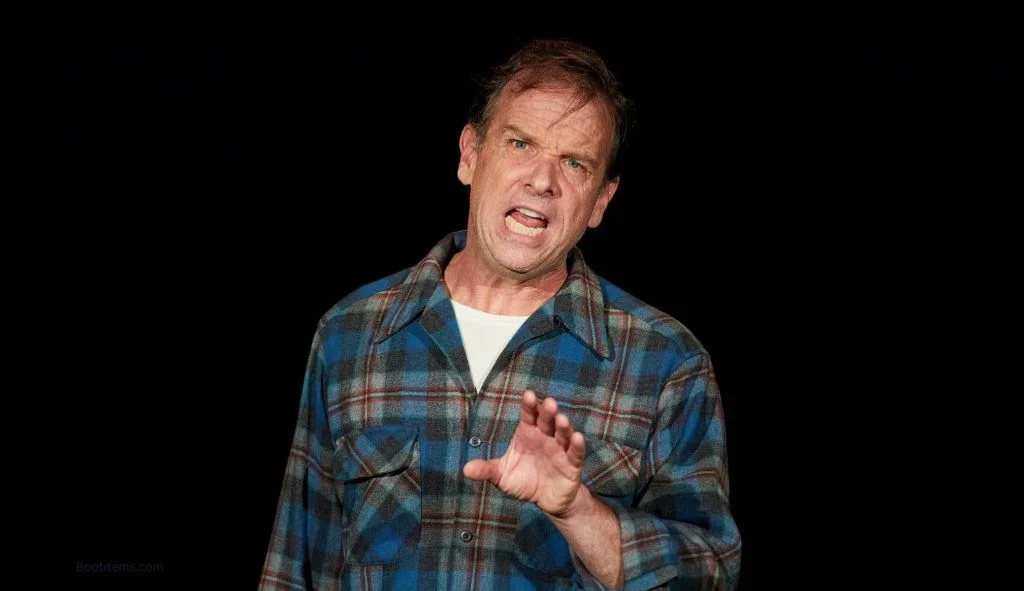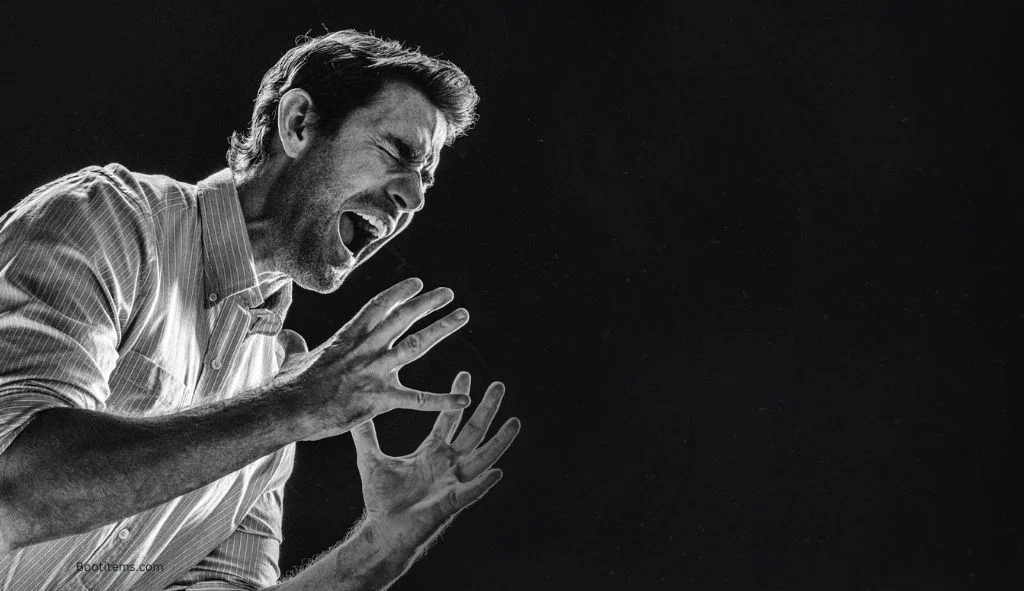Angry Alan Review: A Powerful Take on Men’s Rights Movement
Angry Alan is a powerful one-man play by Penelope Skinner that satirizes the men’s rights movement through the character of Roger, who becomes radicalized after discovering an online activist.
What is Angry Alan?
Penelope Skinner’s one-man play “Angry Alan” has garnered significant critical acclaim since its debut at the Edinburgh Fringe Festival in 2018. The production offers a thought-provoking examination of the men’s rights movement through the eyes of Roger, an ordinary man who finds himself drawn into a world of online radicalization. This review explores the play’s themes, performances, and impact as it continues to be staged in various theaters around the world.
The Premise and Plot
“Angry Alan” centers on Roger, played brilliantly by Donald Sage Mackay in the original production. Roger is a divorced father who has lost his corporate job at AT&T and now works as a third-assistant manager at a Safeway grocery store. Feeling frustrated and depressed about the direction his life has taken, Roger stumbles upon the eponymous Angry Alan while browsing the internet one morning after breakfast.
Angry Alan is an online activist and figurehead of the men’s rights movement who claims that the world is run by women in what he terms a “gynocracy.” Through watching Alan’s YouTube videos, Roger has what he describes as a “red pill moment” – an epiphany that explains all his life’s problems. He comes to believe that he has been living in a cage created by “gynocentric sexism” and excessive feminism.
The play follows Roger’s journey as he becomes increasingly invested in the men’s rights movement. He tries to share his newfound ideology with his girlfriend Courtney, who is taking a feminist course as part of her degree. This creates tension in their relationship, particularly when Roger defends a male harasser during an evening out with Courtney’s friends.
The story culminates with Roger attending a men’s rights conference in Cincinnati where Angry Alan himself is speaking. This trip, combined with a camping excursion with his semi-estranged son Joe, leads to a powerful and unexpected conclusion that forces the audience to confront the real-world consequences of such ideologies.
Performance and Direction
Donald Sage Mackay’s performance as Roger has been universally praised across reviews. His portrayal brings a disarming charm and likability to a character whose views are increasingly troubling. Mackay delivers an hour-long soliloquy with “gunfire precision,” making Roger simultaneously infuriating and endearing.
What makes the performance particularly effective is Mackay’s ability to embody not just Roger but also to suggest the presence of other characters through his narration. This technique is especially powerful in the final scene where he portrays both Roger and his ex-wife, highlighting Roger’s inability to express himself properly.
Penelope Skinner, who both wrote and directed the original production, uses minimal staging to maximum effect. The set typically consists of just a chair or two, with projections of real YouTube videos from men’s rights activists displayed on a screen behind the actor. Peter Small’s lighting and Dominic Kennedy’s sound design punctuate the monologue effectively, creating a pacy rhythm that draws the audience deeper into Roger’s psyche.
Themes and Social Commentary
“Angry Alan” serves as a sharp critique of the men’s rights movement while also exploring broader themes of masculinity in crisis, online radicalization, and the power of echo chambers in shaping worldviews.
The play doesn’t simply mock its subject matter but offers a nuanced examination of how ordinary men can be drawn into extreme ideologies. Roger isn’t portrayed as inherently malicious; rather, he’s shown as someone seeking answers to his genuine feelings of inadequacy and failure. This approach makes the play’s message all the more powerful – it suggests that radicalization can happen to seemingly normal, even likable people.
Skinner’s work is particularly timely in its exploration of how online communities can foster extremism. The play opens with a Facebook feed of anti-feminist trolling, and the incorporation of real-life YouTube videos from the men’s rights movement serves as a stark reminder of how social media can warp perspectives.
The play also touches on the relationship between masculinity and mental health. As Roger becomes increasingly obsessed with men’s liberation, he loses sight of the suffering of others, including his ex-wife, girlfriend, and son. This raises questions about whether Roger’s issues stem from masculinity or mental health, and whether he is both victim and victimizer.

Critical Reception
“Angry Alan” received overwhelmingly positive reviews from critics. It won a Fringe First Award for new writing at the Edinburgh Fringe Festival in 2018 and has been described as “theatrical genius” and “a must-see”.
Critics have particularly praised the play’s ability to make audiences laugh while also making them uncomfortable. The humor serves as an entry point to explore deeply troubling ideas, creating what one reviewer called “a ferocious and dark satirical look at the meninist movement”.
The production has been commended for its subtlety and nuance. Rather than condemning Roger outright, the play allows audiences to make their own judgments, which many reviewers found more effective than a heavy-handed approach. As one critic noted, the play “asks plenty of questions” about masculinity, mental health, and victimhood that linger long after the performance ends.
Impact and Relevance
Since its premiere in 2018, “Angry Alan” has remained relevant as discussions around toxic masculinity, online radicalization, and the men’s rights movement continue to evolve. The play was written in the aftermath of Donald Trump’s election, a period that saw increased visibility for alt-right and men’s rights activists.
The production serves as a cautionary tale about the recruitment of “ordinary” men to extreme causes, making it not just funny but, as one reviewer put it, “a whole lot scarier”. Its examination of how seemingly reasonable people can adopt unreasonable views feels particularly pertinent in an era of increasing political polarization.
Recent productions, such as the one at Northern Light Theatre in 2025, demonstrate the play’s enduring relevance. As the reviewer for the Edmonton Journal noted, the play “examines toxic masculinity through the eyes of a man who could be your neighbor”.
The Significance of “Angry Alan” in Contemporary Theater
“Angry Alan” represents an important contribution to contemporary theater’s engagement with pressing social issues. By focusing on a single character’s journey into radicalization, Skinner creates an intimate portrait that humanizes without excusing problematic behavior.
A Nuanced Approach to Difficult Subject Matter
What sets “Angry Alan” apart from other political theater is its refusal to simplify complex issues. Rather than presenting Roger as a villain, the play shows him as a complex individual whose grievances, while misdirected, stem from real feelings of displacement and inadequacy.
This approach allows the play to explore how the men’s rights movement exploits legitimate concerns – such as high male suicide rates – to promote a harmful ideology. By acknowledging these concerns while critiquing the movement’s solutions, Skinner creates a more compelling and honest examination of the subject matter.
The play also avoids the trap of preaching to the converted. Its humor and Roger’s likability ensure that audiences don’t simply dismiss him, forcing them to engage with uncomfortable questions about masculinity and privilege. As one reviewer noted, there were “a lot of crossed arms in the audience, a lot of hesitant laughter, but when we left there was also a lot of conversation”.
The Power of Monologue as Form
Skinner’s choice to tell this story through a single-character monologue proves particularly effective. By allowing Roger to narrate his own journey, the audience gains insight into his thought processes and the gradual nature of his radicalization.
The monologue format also highlights Roger’s isolation. Despite his newfound community online, he remains fundamentally alone, speaking into a void. This isolation underscores one of the play’s key themes: how the internet can simultaneously connect people and deepen their alienation from those physically present in their lives.
The form also places enormous responsibility on the actor, requiring them to hold the audience’s attention for the full duration of the play. Mackay’s performance has been consistently praised for achieving this difficult feat, bringing nuance and humanity to a character whose views might otherwise alienate viewers.
Technical Elements and Staging
Despite its minimal staging, “Angry Alan” makes effective use of technical elements to enhance its storytelling. The projections of real men’s rights videos serve not just as background but as another character in the play, representing the online world that has captured Roger’s attention.
In the Northern Light Theatre production in 2025, the design included “a web of strings attached to the screen, metaphorical and literal,” symbolizing how Roger has become entangled in this ideology. The lighting design often incorporates red during Roger’s “red pill moments,” visually representing his transformation.
Sound design plays a crucial role as well, with many productions using effects that create tension and underline key moments in Roger’s narrative. The Soho Theatre production in 2019 featured a “soundtrack of punk music” that gave the play “a rousing, galvanising quality”.

Samantha Yates is a creative writer and journalist with expertise in content creation and editing. She holds an MA in Creative Writing and brings professional experience from Lionbridge, where she developed engaging content for leading technology companies







